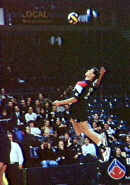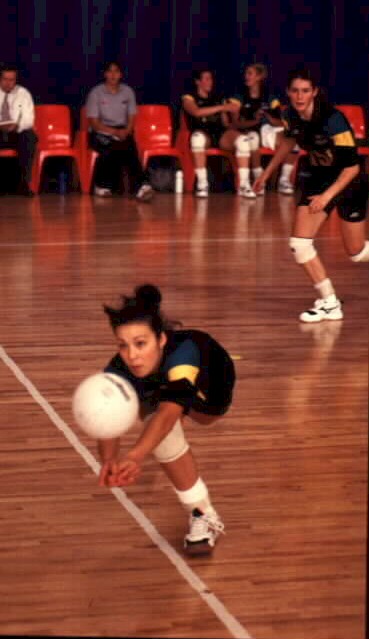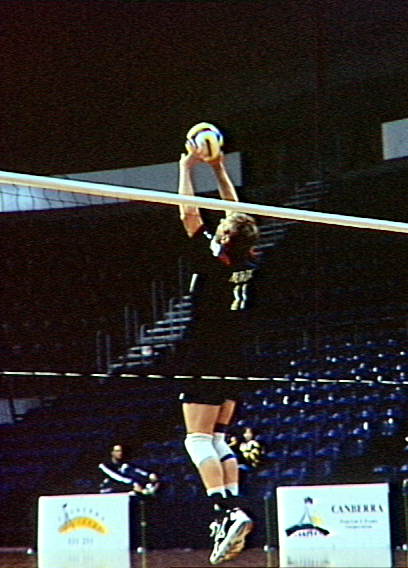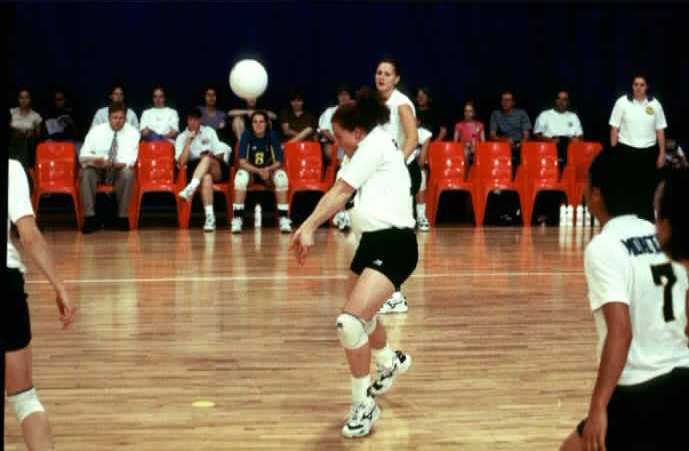 | ||
 |
||
|
| ||
 |
|||||||||||||||||||||
Volleyball Characteristics of the Sport Indoor volleyball rules have undergone a revamp in recent years producing a more dynamic, faster paced game. Matches are generally played to the best of five sets with the first four sets played to 25 and the final set played to 15. Points can now be scored regardless of which team has served. Six players are on court at a time. Six substitutions are allowed per set but substitutes can only enter the game once per set, can only replace a starting player and can only be replaced by the same player. The exception is the libero, a defensive specialist who can substitute into the back-court at any time during the game. Indoor volleyball is a game of explosive strength, agility, skill and concentration. The game relies highly on the anaerobic energy system though aerobic endurance is important for recovery between points, stamina and tolerance to heat. Training At the elite level, players train for 30+ hours per week. Training includes skill, strength and conditioning programs. In addition, athletes may undertake extra individual skill or conditioning sessions. For the elite player, indoor volleyball is a year-round sport. At lower levels, volleyball tends to be a winter sport although short summer rosters may also be run. Many players may play a combination of indoor and beach volleyball throughout the year. Training levels vary from 3-4 sessions a week to no training for those playing in recreational or mixed rosters. Competition Elite indoor volleyball players require frequent match practice. In Australia, this requires regular overseas tours to find quality opponents. Elite players aim for about 50 International matches per year. The majority of indoor volleyball players participate in rosters which involve a weekly match. Weekend tournaments may also be scheduled throughout the year. Physical characteristics Height is an obvious advantage for indoor volleyball players. In addition, having reduced body-fat levels can help optimise speed, agility and jumping ability. Indoor volleyball players need powerful legs to assist with jumping and strong upper bodies to develop power for spiking, serving and blocking. Common Nutrition Issues Training nutrition Young volleyball players tend to have large energy needs to support growth. Add the carbohydrate requirements of a heavy training schedule and the extra carbohydrate required to build muscle, and elite volleyballers end up with a large daily requirement for carbohydrate. All volleyball players need to make nutrient-dense carbohydrate foods such as pasta, rice, bread, cereal, vegetables, fruit and sweetened dairy products the focus of meals and snacks. Players in heavy training need to start recovery nutrition tactics immediately after each training session. Ideally, players should aim to have 50-100 grams of carbohydrate within 30 minutes of finishing training. Recovery snacks should be combined with fluid to replace any fluid lost during the session. Bulking Up Players trying to increase muscle size and strength need a high-energy diet in addition to a quality training program which includes resistance or weights training. The nutritional requirements for increasing muscle bulk and strength include not only the protein needed to form new muscle tissue, but carbohydrate to fuel the training needed to stimulate muscle growth. Other nutrients such as vitamins and minerals may also be needed. In short, increased energy from nutrient-rich foods is required. Achieving a high-energy intake is not as easy as it sounds. It requires organisation and commitment. The following tips will help:
Body Fat A low-moderate body fat level can help to improve speed, agility and jumping ability. Some volleyball players may need to reduce body fat levels at times during their career. The first step to reducing body fat is to forget methods claiming to be magic or miraculous and adopt a consistent, long-term approach to body fat maintenance. Try the following:
Iron status Iron is an important nutrient for sports performance. Some players may have problems with low iron status especially females with low iron intakes. Iron levels should be checked regularly when in heavy training. Iron-rich foods such as lean red meat and breakfast cereals fortified with iron (e.g. Kellogg's Sustain) should be included regularly in the diet. Iron-rich plant foods such as wholegrain cereals, spinach and legumes should be combined with animal iron sources (e.g. wholemeal pasta and bolognaise sauce) or vitamin C sources (a glass of juice consumed with breakfast cereal) to improve iron absorption. A sports dietitian will be able to provide specific dietary help. Fluids during training and games High-intensity exercise in a controlled atmosphere stadium can lead to large sweat losses - especially in large players. Volleyball players need to make the most of opportunities to hydrate during matches - time outs, time spent on the bench, breaks between sets. During training, frequent breaks should be scheduled to allow players to grab a quick drink. Each player should keep their own drink bottle nearby so they can drink whenever the opportunity arises. Water is a suitable fluid, but a sports drink may promote better performance by topping up fuel stores for both the muscle and brain. Volleyball requires skill, concentration and decision- making. These factors are impaired both by dehydration and lowering of blood glucose levels. Sports drinks top up carbohydrate needs during the game, and may also encourage players to drink more fluid. In a recent study of fluid intake practices during training by AIS athletes participating in team sports, we found that men and women both drank more fluid when a sports drink was offered, than when the fluid on offer was plain water. This occurred even though the players reported liking water better! It is an interesting exercise to monitor weight changes of players and their drink bottles during practice and games, and estimate their sweat losses and fluid intakes. The following results were found in studies of the AIS mens (M) and womens (W) volleyball teams. We found considerable variation between sweat rates and drinking patterns of different players - many drank well, but others needed encouragement.
Game Preparation - the pre-event meal The pre-game meal should fuel and hydrate players, but leave them feeling comfortable for the game. Ideally, the menu calls for a high-carbohydrate choice eaten at least 2-3 hours before a game. Pasta with low-fat sauces, rolls or sandwiches, baked potatoes with low fat fillings, creamed rice, and fruit salad with yoghurt, are all examples of suitable choices. Each player or team should experiment to find the routines that work best for their situation. Eating together as a team can be a great way to raise team morale and get focused for the game. It also ensures that all players have their pre-game nutrition needs looked after. Post-game recovery tactic Effective recovery begins with the intake of fluid, carbohydrate and other important nutrients. Left to chance, recovery eating may take a back seat to the post-game meetings, stretching and injury treatment, drug testing, media interviews, or the trip back to home or the team hotel. Many teams organise post-game recovery snacks that can be consumed simultaneously with these activities - sports drinks, liquid meal supplements, fruit, sandwiches and cereal bars are some of the many quick options. Depending on the time of the game and the athlete's appetite, this post-game snack may be supplemented by a later meal. Tournament nutrition and road trips As soon as the match schedule is known, plan a meal routine that schedules appropriate pre-event meals and recovery strategies. When several games are played in succession over as many days, pro-active recovery techniques will be important in maintaining performance right through the end of the schedule. If you are playing away from home, plan where you will be eating meals, and organise the menus in advance. It is stress-free when a hungry team arrives at a restaurant to find buffet-style meals waiting, tailor-made to their special needs. Similarly, take control of meals eaten on planes, buses and other travel options. Always carry some high-carbohydrate snacks such as cereal bars, fruit and yoghurt for emergencies. In hotels, empty the mini bars to make room for more nutritious snacks and drinks. Case Study - The Recovery Bar Volleyball players at the AIS lead extremely busy lives. Two training sessions are scheduled most days. In addition, most players go to University and/or work. When training twice per day it is important for players to recovery quickly between training sessions. However, when players need to rush from training to work or Uni, it can be difficult taking time out for recovery nutrition. Dietitians working with volleyball observed that some players were failing to consume sufficient carbohydrate between training sessions. This was causing some players to fatigue as the week progressed. Some players were struggling to increase muscle mass despite working hard in the gym. Other players were relying on high fat snacks such as chocolate bars bought from vending machines to refuel because these were the only foods available. This was causing unwanted weight gain. Research has shown that athletes should aim to consume about 1g of carbohydrate per kilogram of body weight within 15-30 minutes after the finish of a session in order to facilitate rapid recovery of muscle glycogen levels. For most athletes, this equates to about 50-100g of carbohydrate. Not only does this post-exercise snack help with speedy recovery, but it adds to total energy and fuel needs in the day. With help from sponsors, a 'Recovery Bar' was set up for volleyball teams. A refrigerator was placed courtside and stocked with nutrient-rich foods such as cereal bars, fruit, yoghurt, Sustagen Sport, juice and flavoured milk. Athletes were given instruction as to suitable amounts of food to consume. The following guidelines were provided to help players achieve an intake of approximately 1gram of carbohydrate per kilogram of body weight:
Now players are able to grab a snack as soon as training is finished. Recovery begins as soon as the training session ends and players are better prepared for the next training session. Foods chosen for the AIS Recovery Bars need to be quick, easy to eat, and require minimal preparation and cleaning up. Many other energy and nutrient rich foods can also be added to the recovery menu depending on the situation. The following table has other suggestions for recovery foods:
You will find more information about volleyball at the
Australian Institute of Sport on the
|
| ||||||||||||||||||||
|
The Department of Sports Nutrition is a program of the
Australian Institute of Sport General enquires can be emailed to: aisnutrition@ausport.gov.au Copyright
© Australian Sports Commission
| |||||||||||||||||||||





